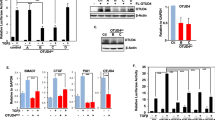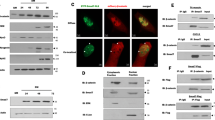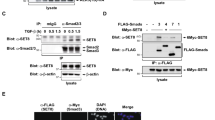Abstract
Smad proteins are essential components of the signalling cascade initiated by members of the Transforming Growth Factor-β family. TGFβ binding to heteromeric complexes of transmembrane Ser/Thr kinases induces Smad2 and Smad3 phosphorylation on their C terminus residues. This phosphorylation leads to oligomerization with Smad4, a common mediator of TGF-β, activin and BMP signalling. The Smad complexes then translocate to the nucleus where they play transcription regulator roles. Even if they share 92% identity, the two TGFβ restricted Smad2 and Smad3 are not functionally equivalent. As we have previously shown, Smad3 acts as a transcription factor by binding to a TGFβ-responsive sequence termed CAGA box whereas Smad2 does not. Smad2 differs from Smad3 mainly in the N-terminal MH1 domain where it contains two additional stretches of amino acids that are lacking in Smad3. Here, we show that one of these domains corresponding to exon 3 is responsible for the absence of Smad2 transcriptional activity in CAGA box-containing promoters. Furthermore, in vitro studies indicate that this domain prevents Smad2 from binding to this DNA sequence. This suggests that Smad2 and Smad3 may have different subsets of target genes participating thus in distinct responses among TGFβ pleiotropic effects.
This is a preview of subscription content, access via your institution
Access options
Subscribe to this journal
Receive 50 print issues and online access
$259.00 per year
only $5.18 per issue
Buy this article
- Purchase on Springer Link
- Instant access to full article PDF
Prices may be subject to local taxes which are calculated during checkout



Similar content being viewed by others
Abbreviations
- TGFβ:
-
Transforming Growth Factor β
- EMSA:
-
Electrophoretic Mobility Shift Assay
References
Attisano L, Wrana JL, López-Casillas F and Massagué J. . 1994 Biochim. Biophys. Acta 1222: 71–80.
Chen Y, Lebrun J-J and Vale W. . 1996 Proc. Natl. Acad. Sci. USA 93: 12992–12997.
Chen X, Rubock MJ and Whitman M. . 1996 Nature 383: 691–696.
Chen Y, Bhushan A and Vale W. . 1997 Proc. Natl. Acad. Sci. USA 94: 12938–12943.
Derynck R and Feng X-H. . 1997 Biochim. Biophys. Acta 1333: F105–F150.
Dennler S, Itoh S, Vivien D, ten Dijke P, Huet S and Gauthier J-M. . 1998 EMBO J. 17: 3091–3100.
Eppert K, Scherer SW, Ozcelik H, Pirone R, Hoodless P, Kim H, Tsui L-C, Bapat B, Gallinger S, Andrulis IL, Thomsen GH, Wrana JL and Attisano L. . 1996 Cell 86: 543–552.
Hahn SA, Schutte M, Shamsul Hoque ATM, Moskaluk CA, da Costa LT, Rozenblum E, Weinstein CL, Fischer A, Yeo CJ, Hruban RH and Kern SE. . 1996 Science 271: 350–353.
Hata A, Lo RS, Wotton D, Lagna G and Massagué J. . 1997 Nature 388: 82–87.
Hata A, Lagna G, Massagué J and Hemmati-Brivanlou A. . 1998a Genes Dev. 12: 186–197.
Hata A, Shi Y and Massagué J. . 1998b Mol. Med. Today 257–262.
Hayashi H, Abdollah S, Qiu Y, Cai J, Xu Y-Y, Grinnell BW, Richardson MA, Topper JN, Gimbrone MA, Wrana JL and Falb D. . 1997 Cell 89: 1165–1173.
Heldin C-H, Miyazono K and ten Dijke P. . 1997 Nature 390: 465–471.
Hocevar BA and Howe PH. . 1998 Miner. Electrolyte Metab. 24: 131–135.
Imamura T, Takase M, Nishihara A, Oeda E, Hanai J-I, Kawabata M and Miyazono K. . 1997 Nature 389: 622–626.
Jonk LJC, Itoh S, Heldin C-H, ten Dijke P and Kruijer W. . 1998 J. Biol. Chem. 273: 21145–21152.
Kim J, Johnson K, Chen HJ, Carroll S and Laughon A. . 1997 Nature 388: 304–308.
Kinglsey DM. . 1994 Genes Dev. 8: 133–146.
Kretzschmar M and Massagué J. . 1998 Curr. Opin. Genet. Dev. 8: 103–111.
Letterio JJ and Roberts A. . 1998 Annu. Rev. Immunol. 16: 137–161.
Liu F, Hata A, Baker JC, Doody J, Cárcamo J, Harland RM and Massagué J. . 1996 Nature 381: 620–623.
Markowitz S, Wang J, Myeroff L, Parsons R, Sun L, Lutterbaugh J, Fan RS, Zborowska E, Kinzler KW, Vogelstein B, Brattain M and Willson JKV. . 1995 Science 268: 1336–1338.
Miyazono K. . 1997 Int. J. Hemat. 65: 97–104.
Nakao A, Afrakhte M, Morén A, Nakayama T, Christian JL, Heuchel R, Itoh S, Kawabata M, Heldin N-E, Heldin C-H and ten Dijke P. . 1997 Nature 389: 631–635.
Parsons R, Myeroff L, Liu B, Willson JK, Markowitz S, Kinzler KW and Vogelstein B. . 1995 Cancer Res. 55: 5548–5550.
Shi Y, Hata A, Lo R-S, Massagué J and Pavletich NP. . 1997 Nature 388: 87–93.
Shi Y, Wang Y-F, Jayaraman L, Yang H, Massagué J and Pavletich NP. . 1998 Cell 94: 585–594.
Takenoshita S, Mogi A, Nagashima M, Yang K, Yagi K, Hanyu A, Nagamachi Y, Miyazono K and Hagiwara K. . 1998 Genomics 48: 1–11.
Topper JN, Cai J, Qiu Y, Anderson KR, Xu Y-Y, Deeds JD, Feeley R, Gimeno CJ, Woolf EA, Tayber O, Mays GG, Sampson BA, Schoen FJ, Gimbrone Jr MA and Falb D. . 1997 Proc. Natl. Acad. Sci. USA 94: 9314–9319.
White RL. . 1998 Cell 92: 591–592.
Yagi K, Goto D, Hamamoto T, Takenoshita S, Kato M and Miyazono K. . 1999 J. Biol. Chem. 274: 703–709.
Yingling JM, Datto MB, Wong C, Frederick JP, Liberati NT and Wang X-F. . 1997 Mol. Cell. Biol. 17: 7019–7028.
Zawel L, Le Dai J, Buckhaults P, Zhou S, Kinzler KW, Vogelstein B and Kern SE. . 1998 Mol. Cell. 1: 611–617.
Zhou S, Zawel L, Lengauer C, Kinzler KW and Vogelstein B. . 1998 Mol. Cell. 2: 121–127.
Acknowledgements
We are grateful to Drs ten Dijke, Massagué and Derynck for gift of vectors. We wish to thank Peter ten Dijke, Didier Grillot, Mike Saunders, Hervé Coste and Philippe Dessen for discussions or technical help.
Author information
Authors and Affiliations
Rights and permissions
About this article
Cite this article
Dennler, S., Huet, S. & Gauthier, JM. A short amino-acid sequence in MH1 domain is responsible for functional differences between Smad2 and Smad3. Oncogene 18, 1643–1648 (1999). https://doi.org/10.1038/sj.onc.1202729
Received:
Revised:
Accepted:
Published:
Issue Date:
DOI: https://doi.org/10.1038/sj.onc.1202729



